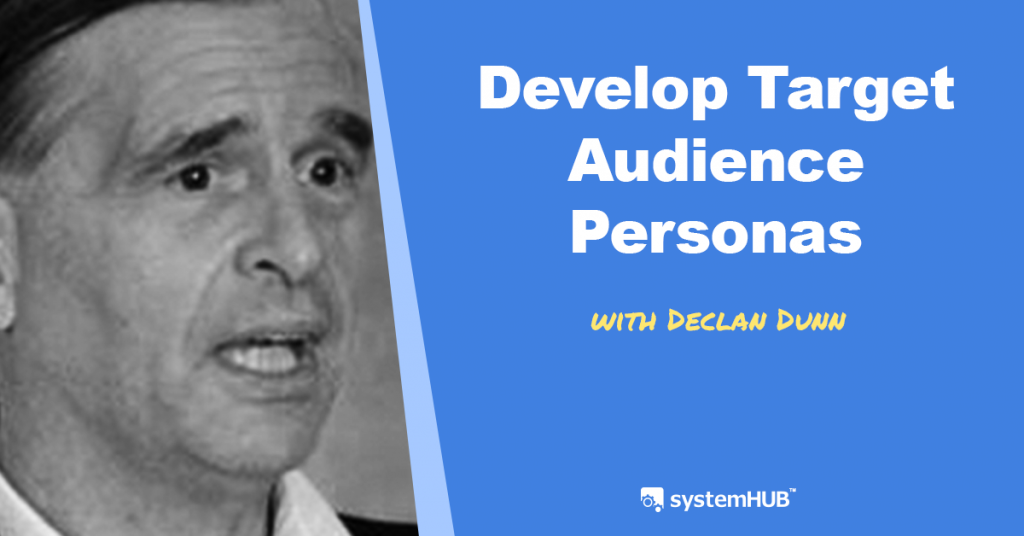Declan Dunn | How to Identify and Define Your Target Audience
- Department: Sales

Overview
This document outlines a process by which you can define three target audience personas.
These personas can then be central to your lead generation and marketing efforts – increasing your conversion rate and ROI marketing efficiency.
=-=-=-=-=-=
System Architect: Declan Dunn
Website: www.declandunn.com
Generated as part of the www.BusinessSystemsSummit.com
Video
The Process
Identify your target audience – Overview
- The diversity of your market is usually divided into 60% one person, 30% another and 10% the other.
- To personalise the lead process, focus on developing the 3 personas.
- Who: age, gender, demographic of your audience.
- Where: their location and online habits.
- Key challenges: understand and define their problem.
- Messaging: where and how do they learn and communicate.
Step 1: Persona development through Search and Trigger words.
- What trigger words does your audience use to describe their problem, What are people searching for?
- Go to SerpStat.com and enter a keyword or competitors URL. Look for the way people describe what they’re looking for and what words are used repeatedly. Note: These words are ideal to use in your own marketing.
- Gather the top 10 initial keywords from organic search, and the top 10 keywords from Paid Adwords (Pay Per Click) results. Compare your customer’s keywords to your competitors Adwords keywords.
- What are the top search results?
- Research the Top 10-20 listings; are they competitors? or/are there terms that make the results muddled?
- Use AHREFs.com to find out who links to these top results, how many links, and how they link (blog posts, reviews, events, etc.)
- What questions are your customers asking?
- These questions form the core of your copy, as well as the content you’ll develop for your website and social media. Identify the most important questions to your target audience and focus on these.
- What content is your competition sharing?
- Use this to determine if you should create similar content, different content, and/or simply update their old content.
- Determine where in the funnel this content is being used – the top of the funnel is for introductory information, the middle is for education, and the bottom of the funnel is for sales and conversion.
Step 2: Persona development through social channels.
- What social channels are most active for your audience?
- Define which social channels are used by your audience, and what time of day they frequently use it. Does this help to identify which social channel will you focus on?
- Who are the influencers and connectors who bring people together?
- Build a list of important, influential and connected people in social media and engage with them. Watch what type of content they are already sharing with your audience.
- Which competitors are actively marketing on social media?
- Keep a list of the headlines and marketing campaigns you find with your competition. What time of year do they run these, and why? What words create the most engagement?
- Which articles are popular?
- Research what types of articles rank highly, get shared, and have the most engagement. Categorise these based on social media channel – does content tend to perform better on one channel or across a combination.
- Use photos and videos, plus small infographics, ad creative photos, and other graphics.
- Suggestion! Use BuzzSumo.com to find the most shared content and key influencers.
Step 3: Persona development through messaging by the numbers.
- Bring your keywords lists, headlines, and content from step 1.
- Rank these based on organic search first and pick out the top 3 messages you’ve found.
- Integrate your lists of social influencers, connections, and content from step 2.
- Rank these by popularity and engagement, while also watching which companies lead in social. Get clear who the Influencers are; what content they published that touched the audience, and when did they post it (month/year)?
- Create/define your 3 key Personas
- Who: age, gender, demographic of your audience.
- Where: their location and online habits.
- Key challenges: help them understand and define their problem.
- Messaging: where and how do they learn and communicate.
- Personalise headlines, keywords, and messaging for each of your 3 key Personas on search and social media.
- Develop tailored marketing for each Persona – you’re looking to tailor beyond just a name… add location, who they work for if relevant, and other info that will catch their attention.
How to Measuring Success
- Understand the 4 types of customers:
- Raw leads: paid inbound and social media marketing.
- Qualified leads: reviewed and followed up for phone calls from sales.
- A phone call or in-person meeting.
- Sales: having purchased your product/service.
- Use Personas Key Performance Indicators (KPI)
- Conversion to social lead: raw leads from initial contact on social.
- Conversion rate – social leads to qualified leads by social channel.
- Cost per qualified leads – before the call.
- Cost per phone or in-person meeting – do they show up?